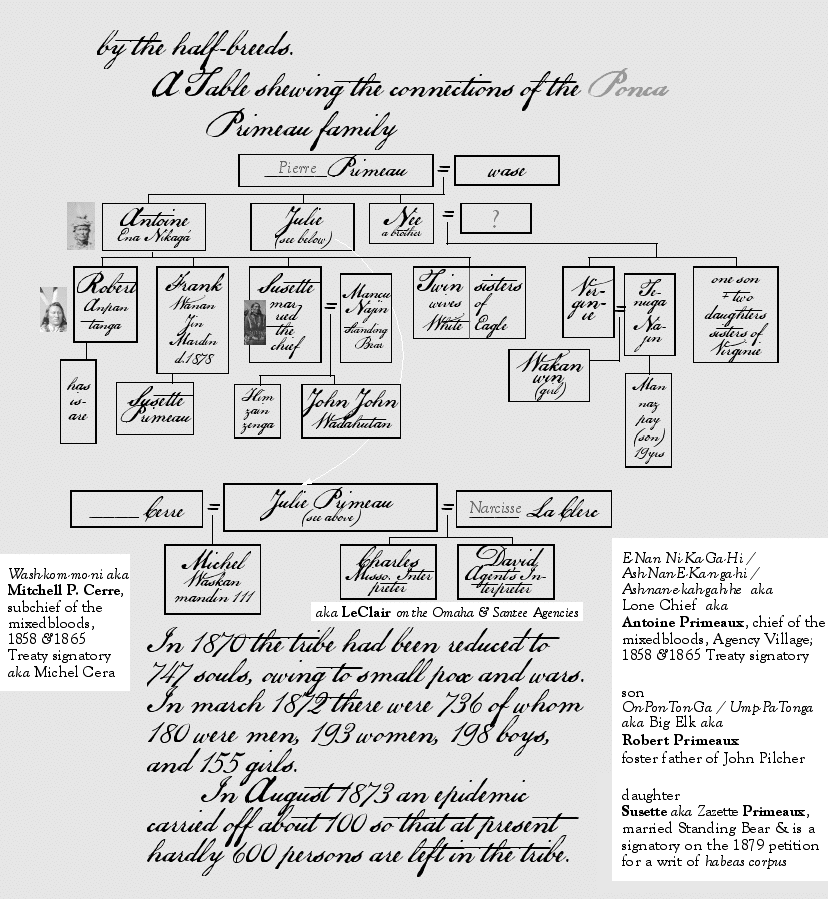
Primeau & Ponca history by James Owen (J.O.) Dorsey, Episcopalian missionary turned ethnologist, ca 1880
Bureau of American Ethnology, National Anthropological Archives, Smithsonian Institution
thanks to Joy Tibbitts of Sioux Falls, South Dakota
• see also reference to Antoine Primeau in Alfred Riggs' (Congregational missionary & 1870 founder of
the Santee Normal Training School) testimony to US Senate 1880 on Removal of the Ponca Indians. 2jan2015
transcription & historical notes by tpkunesh/19dec08
In 1870 the tribe had been reduced to 747 souls, owing to small pox and wars.
In march 1872 there were 736 of whom 180 were men, 193 women, 198 boys, and 155 girls.
In August 1873 an epidemic carried off about 100 so that at present hardly 600 persons are left in the tribe.
|
The first Primeau here is probably Pierre Primeau, born in 1770 in Châteauguay, Québec, 8th of Joseph & Marie-Louise Petit-Lalumiere's 18 children including Pierre's younger brother Paul Charles (13th), born in 1776, both of whom were living in St Louis in 1799.
Paul was an engagé on the first leg up the Missouri River with Lewis & Clark, with whom he met the Ponca on 5 september 1804. Paul fathered Charles, a trader and later interpreter from Pierre up to the Mandan, settling at Standing Rock (Lakota & Dakota) with his fullblood wife, Mary Louise Cyr.
Pierre Primeau was an engagé in 1812 (with Manuel Lisa), a signatory on the 1825 USA treaty with the Ponca, a boatman with the American Fur Company in 1833, and hired by Clark (1836) and Pilcher (1838) as an official (US) Ponca interpreter. The name of his woman, mother of Antoine and Julie and presumably Ponca, is unknown at this time. But given the status of Antoine, Julie and Robert, and the fact that leadership roles were more hereditary than meritorious among the Ponca, one can assume that the woman was the daughter of a chief, and his status carried to the next generations.
E-Nan Ni-Ka-Ga-Hi / Ash-Nan-E-Ka-n-ga-hi /Ash-nan-e-kah-gah-he aka
Lone Chief aka Antoine Primeaux, chief of the mixedbloods, Agency Village; 1858 & 1865 Treaty signatory
his son On-Pon-Ton-Ga / Ump-Pa-Tonga aka Big Elk aka Robert Primeaux, foster father of John Pilcher
his daughter Susette aka Zazette Primeaux, married Standing Bear & is a signatory on the 1879 petition for a writ of habeas corpus
Wash-kom-mo-ni aka Mitchell P. Cerre aka Michel Cera, subchief of the mixedbloods, 1858 & 1865 Treaty signatory
Charles & David Le Clerc aka LeClair on the Omaha & Santee Agencies, interpreters
 notes notes
- the added 'x' on the Primeau surname is found among the Ponca and then Santee Primeau families. 'Primeau' is a french name, and 'x' on the end of french numbers is pronounced 's', but this doesn't seem to be the case here, ie, 'Primeau' and 'Primeaux' are pronounced the same. it is easy to imagine that the french 'x' was added to distinguish between the Primeau brothers' families, or simply adding on their most common form of signature like Pierre's in the 1825 treaty - "his x mark".
- Ponca-Omaha is a southern siouan language and are as closely related to each other as Parisian and Canadian (québécois) french. Ponca and Dakota are linguistic cousins - compare the 'tonga' for big in Ponca with 'tonka' for big in Dakota. (then compare the words for 'elk' in each language and notice how different they are.)
- St Louis area tribes
transcription & historical notes by tpkunesh/19dec08
corrections & comments always welcome.
|